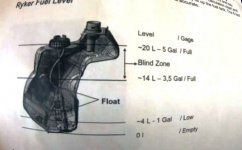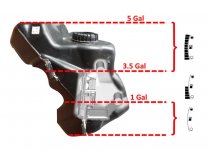The only real thing you should take away from any discussion about Spyder/Ryker fuel gauges is that due to the shape of the tank,
they are inherently INACCURATE!! :banghead:
While you might be lucky enough to be able to link bars on the gauge to gallons in the tank initially &/or occasionally from there on, don't count on it always being the same, cos it'll change as the volume of gas in the tank varies, so there's
NO direct correlation of bars to gallons; just like there's
NO real 'pre-set point or quantity' where the Low Fuel Light will always come on (altho I believe the engineers/designers at least
tried to do that... unsuccessfully! :sour: ) So be warned,
anything you do that
RELIES on your Fuel Gauge &/or Low Fuel Light reporting the remaining fuel in your tank accurately every time is doomed to failure, and relying on them that way could mean that you end up walking &/or damage or destroy your injection system &/or engine too! :gaah:
Just reset a Trip Meter whenever you the refill the tank, then check how many gallons you put in after traveling whatever the number of miles shown at your next fill (& then reset the Trip Meter). You should be able work out roughly (or as accurately as you prefer

) how far you can go on your worst average fill &/or miles per gallon, then if at all possible,
don't ever ride until your tank is empty!! :lecturef_smilie: You
NEED to try to always leave about a 1/2 gallon in the tank to properly cool and lubricate the fuel pump and the high pressure injection system; at the very least you'll need a quart in there to do that; cos if you don't keep that fuel pump immersed in whatever gas is remaining in the tank and that volume of gas is enough to dissipate the heat the pump generates
AND lubricate it properly at the same time, then it'll permanently damage the pump/degrade it's capabilities! :shocked:
Even just running your tank dry
ONCE could cause permanent pump damage, and if it does, from there on in that damage will likely get worse with every rotation of the pump - sure, it might start out microscopic & not all that noticeable or even detectable, but it'll be there, and over time/pump rotations it'll grow, and as it grows it'll reduce the capability of your pump to provide the pressure necessary to let your engine perform as well as it should, and it could also be shedding microscopic debris that progressively damages the injectors too, so that
their spray/fuel atomisation pattern gets worse over time, killing your engine's performance further, knocking your fuel economy for a loop, and by potentially causing dribbles &/or jets of high pressure fuel into the cylinders, possibly even result in piston failure & the eventual destruction of your engine! :yikes:
So don't rely on your Fuel Gauge,
at best it's a vague indicator of what the gas level in your tank is doing,
at worst it's a trap for the unaware that might cause expensive damage!
Use your Trip meter, and if you can possibly avoid it, don't ever ride too close to emptying your tank!
The Fuel Gauge is NOT ACCURATE, and relying on it is NOT SAFE! :lecturef_smilie:


